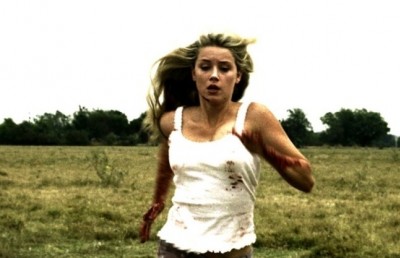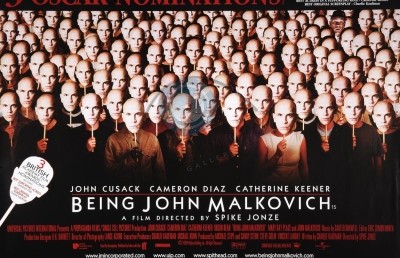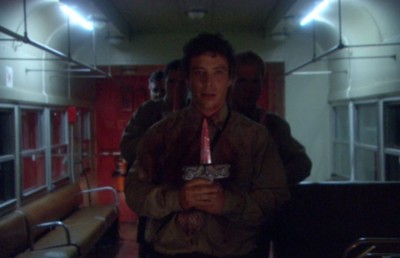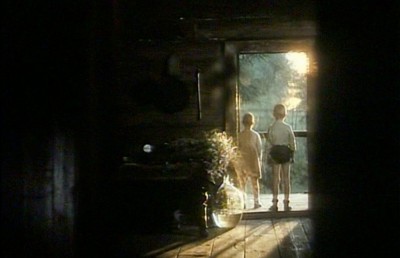Time as visualized by the cinematic medium
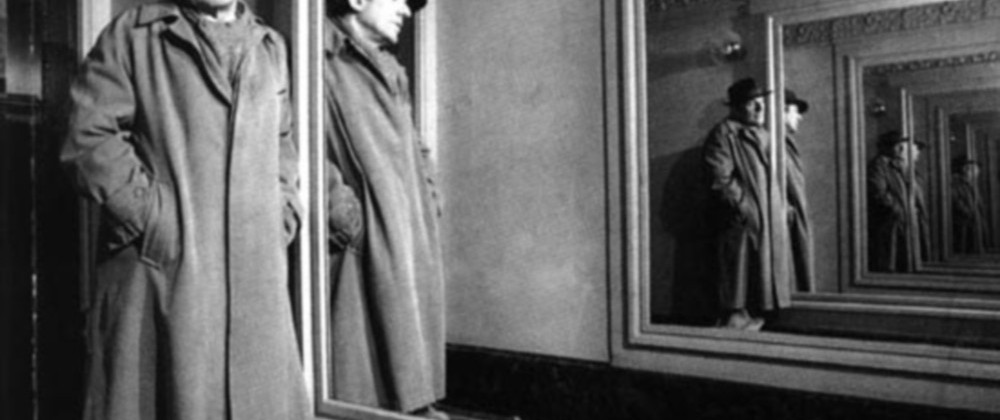
How can we understand, evaluate, and finally value images when the entire culture seems to have gone visual? This seems to be the fundamental question which some discerning critics or philosophers have probed, moving among or beyond ontology, phenomenology, epistemology and ethics, to find an answer. Without the old analogies to Plato’s cave, Freudian dream-work, linguistic, structuralist and psychoanalytic models, the cinema is understood as a system of re-presentation, one that calls upon the inherent conventions of the human mind.
In his two volume work on cinema, Deleuze, considering concepts as the images of thought (Deleuze 1992, xi), offers a study of the medium under a philosophical angle. For him “image and thought merge on what he calls the ‘plane of immanence,’ a transcendental, preindividual, and even prephilosophical field of infinite variation. The plane of immanence is a virtual plane, which is not to say that it is ‘unreal’ or ‘imaginary’ or even something like a field of ‘possibility’; by ‘virtual’, Deleuze means that the plane is composed of incorporealities (events, singularities) that are not the ‘conditions of possibility’ but the genetic conditions in which possibilities are created” (Flaxman 7). To put it another way, as Jean Luc Nancy writes, “the word ‘concept’ means this for Deleuze – making cinematic” (Patton 110).
Given that “time has always put the notion of truth into crisis” (Deleuze 2005, 126), Deleuze declares the engagement of philosophy in the cinematographic images discourse and situates the cinema in the long and vexed relationship between philosophy and time.
His first volume, The movement-image, can be viewed as being connected with the classical notion of Bazin’s so called “analytical decoupage” and his second volume, The time-image, as concerning the post war reversal in the movement – time relationship. “In the tracks of postwar destruction and reconstruction there is no longer any good, any justifiable, reason for the rational linkage of images, and so the cinema undergoes remarkable mutation” (Flaxman 5). “It had to enter into relations with yet other forces, so that it could itself escape from a world of clichés. It had to open up to powerful and direct revelations, those of the time image, of the readable image and the thinking image. It is in this way that opsigns and sonsigns refer back to ‘chronosigns’, ‘lectosigns’ and noosigns’” (Deleuze 2005, 22). Thus, “the relation, sensory-motor situation: indirect image of time is replaced by a non-localizable relation, pure optical and sound situation: direct time-image. Opsigns and sonsigns are direct presentation of time” (Deleuze 2005, 39). This is to say, following Deleuze’s thought, that since the war, the “automatic,” presented primarily as movement-image, indirect representation of time gave way to the formation of the direct time-image, a term which rephrases the Bazinian conceptual adequate of the “image-fact” (Bazin 37), having found its way from Renoir to Italian Neo-realism through Welles, and is being described as duration-image, change-image, relation-image, volume-image which is beyond movement itself (Deleuze 1992, 11). For, “it is only when the sign opens directly on to time, when time provides the signaletic material itself, that the type, which has become temporal, coincides with the feature of singularity separated from its motor associations. It is here that Andrei Tarkosky’s wish comes true: that the cinematographer succeeds in fixing time in its indices [in its signs] perceptible by the senses” (Deleuze 2004, 41).
Bazin’s idea of the realistic illusion as deriving from the transparency of the cinematic technique (and less on the political and social conditions of the films’ production or their influence on the themes they are dealing with), a notion depending on an aesthetic factor, is being therefore replaced by the Deleuzian concept of the phenomenology of time, as captured by the cinematic medium, depending on a philosophical, ontological factor (Augustine’s question “What, then, is time?”). Starting with Kant, when, Deleuze writes, “time ceases to be ordinary or derived, to become the pure form of interiority, which hollows us out, which splits us, at the price of a vertigo, an oscillation that constitutes time: the synthesis of time changes direction by constituting it as an insurmountable abstraction” (Flaxman 4), he follows the thought of Bergson – from Matter and Memory (1896) to Creative Evolution (1907) – for whom, as stated in Creative Evolution, “cinema works with two complementary givens: instantaneous sections which are called images; and a movement or a time which is impersonal, uniform, abstract, invisible, or imperceptible, which is “in” the apparatus, and “with” which the images are made to pass consecutively” (Bergson 322). As Deleuze sums it up, “when the cinema goes through its ‘Kantian’ revolution, that’s to say when it stops subordinating time to motion, when it makes motion depend on time… the cinematic image becomes a time image, an autotemporalization of the image” (Deleuze 1995, 65). “Time is no longer the measure of movement but movement is the perspective of time: it constitutes a whole cinema of time” (Deleuze 2005, 21).
The Deleuzian notion of the time-image, which goes beyond empirical succession of time (described as “a coexistence of distinct durations, or of levels of duration”) (Deleuze 2005, xii), meets, finally, Ricoeur’s reconsideration of the aporetical character of the Augustinian analysis of time, for whom “speculation on time is an inconclusive rumination to which narrative activity alone can respond” (Ricoeur 1984, 6).
Starting from the thesis that the truth claim of every narrative work is the temporal character of human experience, he asserts that “time becomes human time to the extent that it is organized after the manner of a narrative; narrative, in turn, is meaningful to the extent that it portrays the features of temporal experience” (Ricoeur 1984, 3) and tries to prove that “the circle of narrativity and temporality is not a vicious but a healthy circle” (Ricoeur 1984, 3). His methodological and conceptual route is characterized by his effort to reconcile basic Augustian and Aristotelian assertions based on the implication that “the Augustian analysis gives a representation of time in which discordance never ceases to belie the desire for that concordance that forms the very essence of the animus. The Aristotelian analysis, on the other hand, establishes the dominance of concordance over discordance in the configuration of the plot” (Ricoeur 1984, 4). Ricoeur’s answer to Augustine’s major aporia on the problem of the measurement of time (stated in Book 11 of his Confessions) is articulated in his notion of the “distentio animi,” compared with the Aristotelian “muthos,” which is defined as the simultaneity of past, present and future, in the dialectical movement of the soul between memory, attention and expectation (Ricoeur 1984, 20). Thus, to the skeptical argument against the existence of time –time has no being since the future is not yet, the past is no longer, and the present does not remain– the Ricoeurian solution to the ontological paradox offers a phenomenological-narrative way out. This means that after all it is “experience, articulated by language [we speak of time as having being] and enlightened by the intelligence” (Ricoeur 1984, 9) that provides, through our apprehension of the phenomenology of time, the resistance to the thesis of nonbeing. The thesis of the threefold present, which defines that the “the present of past things is the memory; the present of present things is direct perception; and the present of future things is expectation,” (Ricoeur 1984, 11) brings narration in the core of human apprehension of time since “Narration… implies memory and prediction implies expectation. Now, what is to remember? It is to have an image of the past. How is this possible? Because the image is an impression left by events, an impression that remains in the mind” (Ricoeur 1984, 10). It’s easy to note this concept’s resemblance to the Bergsonian definition of the cinematic illusion, bringing in the heart of the cinematic sign, which is always in the present, the philosophical notion of the instant as being the image of eternity, which goes from Hegel and Goethe to Kierkegaard, Heidegger and Merleau-Ponty. Ricoeur’s concept of the Augustinian allusion of human perception of time “in the transit” (Ricoeur 1984, 16) (as perhaps the only possible way to measure it), which constructs his “impression image” (image of the present carrying its past where “the important verb is no longer ‘to pass’ but ‘to remain’” (Ricoeur 1984, 18)) constitutes a “poetical” (and not theoretical) response (Ricoeur 1984, 6) to his notion of the narrative, as considered through a Bergsonian-like cine-fictional angle, since “the mind expects and remembers, and yet expectation and memory are ‘in’ the soul, as impression-images and as sign-images” (Ricoeur 1984, 19).
In a similar way, Deleuze argues that “there is no present which is not haunted by a past and a future, by a past which is not reducible to a former present, by a future which does not consist of a present to come. Simple succession affects the presents which pass, but each present coexists with a past and a future without which it would not itself pass on. It is characteristic of cinema to seize this past and this future that coexist with the present image” (Deleuze 2005, 36). Deleuze’s assumptions on this kind of cinematic perceptual temporality are based on Bergson’s major theses on time, according to which “the past coexists with the present that it has been; the past is preserved in itself, as past in general (non-chronological); at each moment time splits itself into present and past, present that passes and past which is preserved” (Deleuze 2005, 80). Deleuze finds that “Bergsonism has often been reduced to the following idea: duration is subjective, and constitutes our internal life. And it is true that Bergson had to express himself in this way, at least at the outset. But, increasingly, he came to say something quite different: the only subjectivity is time, non-chronological time, grasped in its foundation, and it is we who are internal to time, not the other way round” (Deleuze 2005, 80). With Bergson “the time-image extends naturally into a language-image, and a thought-image. [For] what the past is to time, sense is to language and idea to thought” (Deleuze 2005, 96). The perspective offered to Deleuze thus indicates that “the optical (and sound) image in attentive recognition does not extend into movement, but enters into relation with a ‘recollection-image’ that it calls up… what would enter into relation would be the real and the imaginary, the physical and the mental, the objective and the subjective, description and narration, the actual and the virtual… each time it is a plane or a circuit, so that the thing passes through an infinite number of planes or circuits, which correspond to its own ‘layers’ or its aspects” (Deleuze 2005, 44). “The purely optical and sound situation (description) is an actual image, but one which, instead of extending into movement, links up with a virtual image and forms a circuit with it. The problem is to know more precisely what is capable of playing the role of virtual image. What Bergson calls ‘recollection-image’ seems at first sight to have requisite qualities… The recollection-image is not virtual, it actualizes a virtuality on its own account. This is why the recollection-image does not deliver the past to us, but only represents the former present that the past was… Thus the image has to be present and past, still present and already past, at once and at the same time. If it was not already past at the same time as present, the present would never pass on. The past does not follow the present that it is no longer, it coexists with the present it was. The present is the actual image, and its contemporaneous past is the virtual image, the image in a mirror… The virtual image in the pure state is defined, not in accordance with a new present in relation to which it would be (relatively) past, but in accordance with the actual present of which it is the past, absolutely and simultaneously” (Deleuze 2005, 45, 52, 76, 77).
In the Aristotelian concept of emplotment (muthos) Ricoeur finds the opposite reply to Augustine’s “distentio animi” and the actualization of the narrative attempt to manipulate the simultaneity’s temporal paradox. Given that “human action can be narrated…because it is always already articulated by signs, rules, and norms” (Ricoeur 1984, 57), Ricoeur draws particular attention to the syntagmatic order of narrative discourse which implies the irreducibly diachronic character of every narrated story. However, if succession can be subordinated to some logical connection “it is because the ideas of beginning, middle and end are not taken from experience. They are not features of some real action but the effects of the ordering of the poem” (Ricoeur 1984, 39). This assertion along with the one taking into account that the length of the poem consists of the work’s time and “not the time of events in the world” (Ricoeur 1984, 39), is considering the tragic muthos as being set up as the poetic solution to the speculative paradox of time. By further elaborating his assertions on the temporal structure of emplotment, Ricoeur finally concludes that “It is this ‘followability of a story that constitutes the poetic solution to the paradox of distention and intention” (Ricoeur 1984, 67).
This exact notion of “followability” is centered in the core of the epistemological analysis of narrative fiction and visual perception as put under the angle of cognitive science (Gestalt theories in the neo formalist perspective of cine-narratology) and its awareness of “patterns,” for instance, “purpose,” “arrangement of elements,” “intention,” “narrative expectations,” “cognitive schemata,” “creating metaphors” (Ricoeur 1984, 21) [1] or the “Aristotelian notion of verisimilitude” (Branigan 28).
According to Branigan, the spectator’s interpretive process, which involves time, “works top-down on the data. The impetus for creating a story time does not derive in any simple way from the running time of the film – screen time – but rather from top down processes seeking a new order… Physical continuity on the screen depends on the use of equipment… The perception of narrative continuity however, is a very different matter. Indeed it turns out that the best perception of narrative continuity is often obtained by certain violations of physical continuity” (Branigan 45). For giving such a description of the cinematic interpretive process, he calls upon Hume’s assumptions, which argue that “what we call a mind, is nothing but a heap or collection of different perceptions” (Branigan 46). These perceptions and thoughts “succeed each other with an inconceivable rapidity, and are in a perceptual flux and movement” (Branigan 46). Hume could not find any common feature or continuing link, among the perceptions that could qualify as a unified Self. In a similar way Rudolf Arnheim is trying to explain the perceptual process of understanding a film: “At any particular moment we may not know what will come next, but we must not dismiss from our consciousness what we have heard or seen before. The work grows step by step into a whole, and as we accompany its progress we must constantly hark back to what has disappeared from direct perception by ear or eye, but survives in memory. The past as such is never available to the mind. The percepts and feelings, not only of yesterday but of a second ago, are gone. They survive only to the extent that within us they have left remnants, i.e. memory traces. Whatever the nature of these traces in the brain, they certainly persist in spatial simultaneity, influence one another, and are modified by new arrivals” (Arnheim 374, 375). This means that “The whole work must be simultaneously present in the mind if we are to understand its development, its coherence, the interrelations among its parts… In any case it requires simultaneity and therefore is hardly temporal” (Arnheim 374).
All is to say that “between the activity of narrating a story and the temporal character of human experience there exists a correlation that is not merely accidental but that presents a transcultural form of necessity” (Ricoeur 1984, 52). This is particularly true when considering the cinematic form of narrative, given the inherent temporal character of the cinematic illusion as it substantiates human perception. However, “if it is true that the major tendency of modern theory of narrative –in historiography and the philosophy of history as well as in narratology– is to ‘dechronologize’ narrative, the struggle against the linear representation of time does not necessarily have as its sole outcome the turning of narrative into ‘logic,’ but rather may deepen its temporality. Chronology – or chronography – does not have just one contrary, the a-chronology of laws or models. Its true contrary is temporality itself” (Ricoeur 1984, 30).
This non-chronological condition of sinking into the true temporality of human experience (embodied, in any case, into cinematic perception) is what one can find to characterize what Bazin calls “the American film par excellence” (in Bazin 1971), the most traditional of all cinematic genres, the western. The western, which was primarily constructed as an hymn to the birth of a new land demanding “the simultaneous birth of a new culture, with its roots necessarily in the past, but its blossom in the timeless experience of the never-ending frontier” (Nashbar, 93), [2] turned out to be the reflective portrayal [3] of the epic hero who, torn between naturalness of the wilderness and the artifice of civilization, inhabits a timeless environment [4] defined by a landscape upon which he is fated to carry out his destiny. “A transformation into an epic is evident in the set-ups of the shots, with their predilection for vast horizons, all-encompassing shots that constantly bring to mind the conflict between man and nature. The western has virtually no use for the closeup, even for the medium shot, preferring by contrast the traveling shot and the pan which refuse to be limited by the frameline and which restore to space its fullness” (Bazin 147). In such an organic representation of milieu, “there is not yet any interiority, for there is not yet any exterior, any ‘otherness’ for the soul… Hence the passivity of the epic hero that Goethe and Schiller insisted on: the adventures that fill and embellish his life are the form taken by the objective and extensive totality of the world; he himself is only the luminous center around which this unfolded totality revolves, the inwardly most immobile point of the world’s rhythmic movement” (Lukács 30,89).
The history of the evolution of the western moves from the representation of Rousseau’s “noble savage” (John Ford), who incorporates the dialectic subject-object (soul-form) union of the epic world, the continuity of the man-environment relationship and the reconnection with the lost center of the world’s soul, fulfilled in the emblematic power of the character and the situation’s reflexive images, towards the “novelistic” qualities (those of the “romanticism of disillusionment”) (Lukács) of Anthony Mann’s films (see Bazin), which dramatize Lukács’ allusion of the romantic hero’s justification into failure or defeat (Lukács, “The foundering of form against life”). As Philip French points out: “Perhaps the most marked characteristic of the genre since the early Fifties has been its increasing emphasis not upon victory and success but upon losing – the suggestion that to remain true to oneself will almost invariably result in defeat” (French 52). The “mature sense of limitation and unavoidable guilt [as paying the constant price of the fall] is what gives the Westerner a ‘right’ to his melancholy” (Talbot 154).
In the epic world of the western, “the life-immanence of meaning is so strong that it abolishes time: life enters eternity as life, the organic retains nothing of time except the phase of blossoming” (Lukács 122), when, what the romantic hero experiences and the way he experiences it “has the blissful time-removed quality of the world of gods” (Lukács 122). “Time is the fullness of life, although the fullness of time is the self-abolition of life and, with it, of time itself” (Lukács 123).
In such a non-chronological temporal condition, the European post war cinema, which gave body to the time-image, “the phantom which has always haunted the cinema” (Deleuze 2005, 40), has situated a new kind of romantic character, being put in the midst of the so-called (by Deleuze) “any-spaces-whatever,” where, “even the body is no longer exactly what moves; subject of movement or the instrument of action, it becomes rather the developer of time, it shows time through its tiredness and waitings (Antonioni)” (Deleuze 2005, xii). These “any-spaces-whatever” no longer obey laws of traditional, commonsensical causality. Beyond the reflexive scheme of action and reaction, which dominated in classical cinema (the movement-image), postwar European cinema discovers a cinema of inaction, waiting and exhaustion; the image does not extend to new spaces but “intends,” involuting into the mind, opening up a whole new sense of mental duration, an involution into psychic states, a cinematic lapse into the intensity of the brain.
In the same milieu of timelessness, Pasolini traces the creation of what he calls the “cinema of poetry,” established in an aesthetic technique which he calls “free indirect subjective,” with parallels to the literary “free indirect discourse,” defined as “an interior monolog in images” in which “the story is told through the character, and in an absolute interiorization of the system of allusions belonging to the author” (Nichols 551) (Antonioni’s stylistic device being an example).
This merger of the character’s and director’s subjectivities into an objective-like image, which is found for Bazin in the interaction of aestheticism, realism and reality in the neo-realistic films, as the physical-mental correlation of the image’s virtuality reflected in the mirror, is being transformed, for Deleuze, into Antonioni’s “critical objectivism” (Deleuze 2005, 6), which gives the impression that, by transforming the action into displacement of figures in space, “it is as if the most objective images are not formed without becoming mental, and going into a strange, invisible subjectivity” situating him closer to Nietzsche as being “the only contemporary author to have taken up the Nietzschean project of a real critique of morality, and this thanks to a ‘symptomatologist’ method” (Deleuze 2005, 8). The virtual images which impersonally follow a becoming, that is a development of consequences in a story, none the less are subject to rapid breaks, interpolations and “infinitesimal injections of atemporality” (Deleuze 2005, 8). “The facts follow one another, and the mind is forced to observe their resemblance; and thus, by recalling one another, they end by meaning something which was inherent in each and which is, so to speak, the moral of the story –a moral the mind cannot fail to grasp since it was drawn from reality itself ” (Bazin 36), creating, thus, “an essential ethical and metaphysical aspect of our relations with the world.” (Bazin 62).
Situated in any-spaces-whatever, where time does not itself change, but only in another time, indefinitely, these virtual images reach the absolute, as instances of pure contemplation, and immediately bring about the identity of the mental and the physical, the real and the imaginary, the subject and the object, the world and the I. By making time “the visual reserve of events in their appropriateness” (Deleuze 2005, 17), they replace the quest involving movement, with a specific weight of time operating inside characters, and make it necessary “to move towards a limit, to make the limit of before the film and after it pass into the film and to grasp in the character the limit that he himself steps over in order to enter the film and leave it, to enter into the fiction as into a present which is inseparable from its before and after” (Deleuze 2005, 36). This way, “the direct time-image always gives us access to that Proustian dimension where people and things occupy a place in time which is incommensurable with the one they have in space” (Deleuze 2005, 37).
In sum, the identification of the phenomenology of time with the perceptual structures of human experience as realized by the cinematic discourse, along with the exploration of the internalized temporality of the human condition which (as stated by Deleuze) has always haunted film history, reaffirms the perseverance of narrative in contemporary cinematic culture.
Endnotes
1 According to Ricoeur “… the metaphor of the transit of events through the present seems unsurpassable. It is a good metaphor, a living metaphor, in that it holds together the idea of ‘passing away,’ in the sense of ceasing, and that of ‘passing through,’ in the sense of relegating.”
2 The Turner thesis concerning the role of the frontier in American history, edited by George Rogers Taylor, Boston: D.C.Heath and Co., 1956.
3 According to Lukács: “Epic interiority is always reflexive” (The theory of the novel, trans. Anna Bostock, Cambridge: The MIT Press, 1971, p. 114).
4 About the timelessness of the epic see: Georg Lukács, “The romanticism of disillusionment” in The theory of the novel.
References
Arnheim, Rudolf, Art and visual perception, Berkeley: Univ. of California Press, (1954), 1974.
Bazin, André, What is Cinema ? vol.,2, trans. Hugh Gray, Univ. of California Press, 1971.
Bergson, Henri, Creative Evolution, trans. Arthur Mitchell, 1954.
Branigan, Edward, Narrative comprehension and film, London: Routledge, 1992.
Deleuze, Gilles, Cinema 1: The movement-image, trans. Hugh Tomlinson, Barbara Habberjam, London: The Athlone Press, 1992.
Deleuze, Gilles, Cinema 2: The time-image, trans.: Hugh Tomlinson, Robert Galeta, London: Continuum, 2005.
Deleuze, Gilles, Negotiations, 1972 – 1990, trans. Martin Joughin, New York: Columbia Univ. Press, 1995.
Flaxman, Gregory (ed.), The brain is the screen: Deleuze and the philosophy of cinema, University of Minnesota Press, 2000.
French, Philip, Westerns: Aspects of a movie genre, London: Secker & Warburg, 1973.
Löwith, Karl, From Hegel to Nietzsche: The revolution in nineteenth century thought, Columbia Univ. Press, 1991 (revisited).
Lukács, Georg, The theory of the novel, trans.: Anna Bostock, Cambridge: The MIT Press, 1971.
Nachbar, Jack (ed.), Focus on the western, Englewood Cliffs, New Jersey: Prentice Hall, 1974.
Nichols, Bill (ed.), Movies and Methods, Berkeley: University of California Press, 1976.
Pasolini, Pier Paolo, “The cinema of poetry” in Bill Nichols (ed.), Movies and methods, Univ. of California Press, 1976.
Patton, Paul (ed.), Deleuze: A Critical Reader, Oxford: Blackwell, 1996.
Ricoeur, Paul, Time and Narrative, vol. 1, 2, trans. Kathleen McLauglin and David Pellauer, Chicago and London: Univ. of Chicago Press, 1984, 1985.
Simmon, Scott, The invention of the western film, Cambridge: Cambridge Univ. Press, 2003.
Solomon, Staley J., Beyond formula: American film genres, Harcourt Brace, 1976.
Talbot, Daniel (ed.), Film: An Anthology, Berkeley: Univ. of California Press, 1975.


